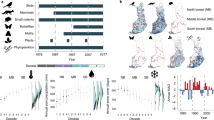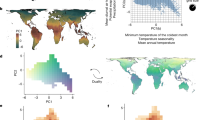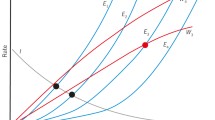Abstract
Extensive empirical work has shown that species richness decreases roughly exponentially or quadratically with latitude. What appears to be a latitudinal gradient in fact may simply be a negative correlation of latitude with area at that latitude, due to convergence of lines of meridian at the poles. There is simply less area at high latitudes, which means fewer niches and fewer opportunities for speciation, hence diminished biodiversity at high latitudes. Similarly, analytic geometry of a cone shows that species number should decrease linearly with altitude on a conical mountain. Here, I provide an explicit mathematical model of the area hypothesis of species richness along latitude and altitude gradients. I re-analyze a previously published latitudinal gradient dataset and show that species number is a linear function of the predicted area and that species number is more fully explained by predicted area than by a quadratic function of latitude. However, analytic geometry is not needed if precise measures of area are known.



Similar content being viewed by others
References
Begon M, Harper J, Townsend C (1996). Ecology: individuals, populations, and communities, 3rd edn. Blackwell, Oxford
Collins M, Vázquez D, Saunders N (2002) Species–area curves homogenization and loss of global diversity. Evol Ecol Res 4:457–464
Colwell R, Hurtt G (1994) Nonbiological gradients in species richness and a spurious Rapoport effect. Am Nat 144:570–595
Colwell R, Lees D (2000) The mid-domain effect: geometric constraints on the geography of species richness. Trends Ecol Evol 15:70–76
Grytnes J, Vetaas O (2002) Species richness and altitude: a comparison between null models and interpolated plant species richness along the Himalayan altitudinal gradient, Nepal. Am Nat 159:294–304
Hillebrand H (2004) On the generality of the latitudinal diversity gradient. Am Nat 163:192–211
Jetz W, Rahbek C (2001) Geometric constraints explain much of the species richness pattern in African birds. Proc Natl Acad Sci USA 98:5661–5666
Lees D, Kremen C, Andriamampianina L (1999) A null model for species richness gradients: bounded range overlap of butterflies and other rainforest endemics in Madagascar. Biol J Linnean Soc 67:529–584
Lyons S, Willig M (1999) A hemispheric assessment of scale dependence in latitudinal gradients of species richness. Ecology 80:2483–2491
Körner C (2000) Why are there global gradients in species richness? Mountains might hold the answer. Trends Ecol Evol 15:513–514
Martin P, McKay J (2004) Latitudinal variation in genetic divergence of populations and the potential for future speciation. Evolution 58:938–945
Pianka E (1966) Latitudinal gradients in species diversity: a review of concepts. Am Nat 100:33–46
Rahbek C (1995) The elevational gradient of species richness: a uniform pattern? Ecography 18:200–205
Rohde K (1992) Latitudinal gradients in species diversity: the search for the primary cause. Oikos 65:514–527
Rosenzweig M (1995). Species diversity in space and time. Cambridge Univ Press, Cambridge
Stevens G (1992). The elevational gradient in altitudinal range: an extension of Rapoport’s latitudinal rule to altitude. Am Nat 140:893–911
Terborgh J (1973) Notion of favorableness in plant ecology. Am Nat 107:481–501
Willig M, Lyons S (1998) An analytical model of latitudinal gradients of species richness with an empirical test for marsupials and bats in the New World. Oikos 81:93–98
Witman J, Etter R, Smith F (2004) The relationship between regional and local species diversity in marine benthic communities: a global perspective. Proc Natl Acad Sci USA 101:15664–15669
Acknowledgements
Thanks to three anonymous reviewers for greatly improving this manuscript.
Author information
Authors and Affiliations
Corresponding author
Rights and permissions
About this article
Cite this article
Gorelick, R. Species Richness and the Analytic Geometry of Latitudinal and Altitudinal Gradients. Acta Biotheor 56, 197–203 (2008). https://doi.org/10.1007/s10441-008-9048-7
Received:
Accepted:
Published:
Issue Date:
DOI: https://doi.org/10.1007/s10441-008-9048-7




